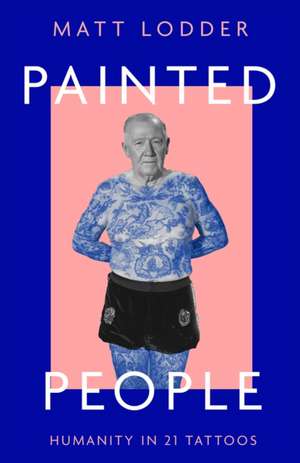Painted People
Autor Matt Lodderen Limba Engleză Hardback – 9 mai 2023
| Toate formatele și edițiile | Preț | Express |
|---|---|---|
| Paperback (2) | 70.64 lei 3-5 săpt. | +12.86 lei 4-10 zile |
| HarperCollins Publishers – 30 sep 2023 | 70.64 lei 3-5 săpt. | +12.86 lei 4-10 zile |
| HarperCollins Publishers – 27 oct 2022 | 96.71 lei 3-5 săpt. | +18.82 lei 4-10 zile |
| Hardback (1) | 128.76 lei 3-5 săpt. | +24.13 lei 4-10 zile |
| HarperCollins Publishers – 9 mai 2023 | 128.76 lei 3-5 săpt. | +24.13 lei 4-10 zile |
Preț: 128.76 lei
Nou
24.64€ • 25.73$ • 20.35£
Carte disponibilă
Livrare economică 25 martie-08 aprilie
Livrare express 08-14 martie pentru 34.12 lei
Specificații
ISBN-10: 000840206X
Pagini: 352
Dimensiuni: 161 x 238 x 35 mm
Greutate: 0.59 kg
Editura: HarperCollins Publishers
Notă biografică
Matt Lodder
Descriere
In 1881, a writer in the Saturday Review called tattooing 'an art without a history'. 'No-one', it went on, 'has made it the business of his life to study the development of tattooing.' Until now.Painted People is a beguiling and intimate look at an untold history of humanity.The earliest tattoos yet identified belonged to Otzi, the 'iceman', whose mummy allows us a brief glimpse into the prehistory of the practice. We know that over the more than five thousand years since he was tattooed, countless cultures have performed this ancient practice, and people in every corner of the world have been tattooed.
For the most part, these fascinating histories remain stubbornly untold, and the secrets of Siberian princesses, Chinese generals and Victorian socialites have been hidden on the skin, under layers of clothing and under layers of history. Now with access to a wealth of new and unreported material, this book will roll up its sleeves and reveal the artwork hidden beneath them.In Painted People, Dr Matt Lodder, one of the world's foremost experts on tattooing, tells the stories of people like Arnaq, who was tattooed in keeping with her cultural and religious traditions in sixteenth-century Canada, and Horace Ridler, who was tattooed as a means to make money in 1930s London. And in between these two extremes, he describes tattoos inked for love, for loyalty, for sedition and espionage and for self-expression, as well as tattoos inflicted on the unwilling, to ostracise.
Taken together, these twenty-one tattoos paint a portrait of humanity as both artist and canvas.










